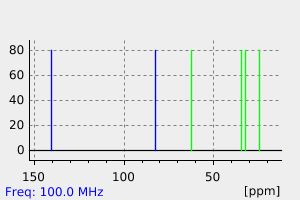(Z)-6-碘-5-己烯-1-醇 | 132716-07-5
中文名称
(Z)-6-碘-5-己烯-1-醇
中文别名
——
英文名称
(Z)-6-iodo-5-hexene-1-ol
英文别名
(Z)-6-iodo-5-hexen-1-ol;(Z)-6-iodohex-5-en-1-ol;cis-6-iodo-5-hexen-1-ol;6-iodohex-5-ene-1-ol;(Z)-6-iodo-5-hexenol;6-Iodohex-5-en-1-ol
CAS
132716-07-5;106335-91-5
化学式
C6H11IO
mdl
——
分子量
226.057
InChiKey
QCWVONALSRPESX-HYXAFXHYSA-N
BEILSTEIN
——
EINECS
——
-
物化性质
-
计算性质
-
ADMET
-
安全信息
-
SDS
-
制备方法与用途
-
上下游信息
-
文献信息
-
表征谱图
-
同类化合物
-
相关功能分类
-
相关结构分类
物化性质
-
沸点:239.7±33.0 °C(Predicted)
-
密度:1.643±0.06 g/cm3(Predicted)
计算性质
-
辛醇/水分配系数(LogP):1.9
-
重原子数:8
-
可旋转键数:4
-
环数:0.0
-
sp3杂化的碳原子比例:0.67
-
拓扑面积:20.2
-
氢给体数:1
-
氢受体数:1
上下游信息
-
下游产品
中文名称 英文名称 CAS号 化学式 分子量 (Z)-5-癸烯-1-醇 (Z)-dec-5-en-1-ol 51652-47-2 C10H20O 156.268
反应信息
-
作为反应物:描述:参考文献:名称:顺序闭环复分解/ Pd催化,Si辅助的交叉偶联反应:高度取代的不饱和醇和含有1,3-顺式–顺式二烯单元的中型环的一般合成摘要:已经开发了顺序闭环复分解/硅辅助交叉偶联方案。烯丙基,均烯丙基和双(均烯丙基)醇的烯基二甲基甲硅烷基醚用Schrock催化剂进行容易的闭环,分别得到5、6和7元环烯基硅氧烷,在某些情况下在两个烯基碳上均具有取代基。这些硅氧烷是高效偶联剂,可以高产率,高特异性和良好的官能团相容性提供苯乙烯和二烯(具有各种芳基和烯基卤化物)。在[allylPdCl] 2的存在下,带有Z-碘链烯基醚的硅氧烷会经历分子内偶联过程,这是构造具有内部1,3-内径的中型环的有效方法顺式–顺式二烯单元。9元,10元,11元和12元碳环二烯的形成以良好的收率实现。还已经完成了对9元环不饱和醚的合成的扩展。该过程的值得注意的特征包括:(1)高度立体定向的分子内偶联,(2)显露的羟基的灵活定位,以及(3)可能扩展到其他中型碳环和杂环。DOI:10.1016/j.tet.2004.06.149
-
作为产物:参考文献:名称:分子内硅辅助交叉偶联反应:含有 1,3-顺式-顺式二烯单元的中等大小环的一般合成摘要:已开发出闭环复分解和 Pd 催化、硅辅助分子内交叉偶联的组合,为构建具有内部 1,3-顺-顺二烯单元的中等大小的环提供一种有效且强大的方法。带有 Z-碘代烯基系链的烯丙醇可以用氯二甲基乙烯基硅烷进行甲硅烷基化,并进行钼催化的闭环复分解反应以形成不饱和硅氧烷。在 [allylPdCl](2) 存在下用四丁基氟化铵活化硅氧烷会导致高产的闭环反应形成 9-、10-、11-和 12-元环。扩展到 9 元环不饱和醚的合成也已完成。该过程的显着特点包括:(1)高度立体特异性的分子内偶联过程,DOI:10.1021/ja0178158
文献信息
-
15-hydroxyeicosatetraenoic acid analogs with enhanced metabolic stability and methods of their use in treating dry eye disorders申请人:Alcon Universal Ltd.公开号:US06348496B1公开(公告)日:2002-02-1915-HETE derivatives with enhanced metabolic stability and methods of their use for treating dry eye are disclosed.15-HETE衍生物具有增强的代谢稳定性,并公开了它们用于治疗干眼症的方法。
-
Highly Stereospecific, Palladium-Catalyzed Cross-Coupling of Alkenylsilanols作者:Scott E. Denmark、Daniel WehrliDOI:10.1021/ol005565e日期:2000.2.1[reaction: see text] Alkenylsilanols bearing methyl ((E)-1 and (Z)-1) or isopropyl ((E)-2 and (Z)-2)) substituents are converted to disubstituted alkenes by a palladium(0)-catalyzed cross-coupling reaction with aryl or vinyl iodides in the presence of tetrabutylammonium fluoride or hydroxide. Yields and stereoselectivities are generally high, and the reaction is compatible with a wide range of functional
-
Cross-coupling reaction of organosilicon nucleophiles申请人:——公开号:US20020183516A1公开(公告)日:2002-12-05Improved methods for generating a —C—C— bond by cross-coupling of a transferable group with an acceptor group. The transferable group is a substituent of an organosilicon nucleophile and the acceptor group is provided as an organic electrophile. The reaction is catalyzed by a Group 10 transition metal complex (e.g., Ni, Pt or Pd), particularly by a palladium complex. Certain methods of this invention use improved organosilicon nucleophiles which are readily prepared, can give high product yields and exhibit high stereo selectivity. Methods of this invention employ activating ions such as halides, hydroxide, hydride and silyloxides. In specific embodiments, organosilicon nucleophilic reagents of this invention include siloxanes, particularly cyclic siloxanes. The combination of the cross-coupling reactions of this invention with ring-closing metathesis, hydrosilylation and intramolecular hydrosilylation reactions provide useful synthetic strategies that have wide application.
-
Visible-Light-Induced Photocatalytic Reductive Transformations of Organohalides作者:Hyejin Kim、Chulbom LeeDOI:10.1002/anie.201203599日期:2012.12.3A photo opportunity: A visible‐light‐excited iridium catalyst delivers electrons from an amine to an organohalide. The electron transfer then induces reductive scission of the carbon–halogen bond, generating the corresponding alkyl, alkenyl, and aryl radical that can undergo cyclization and hydrodehalogenation reactions.一个照相机会:可见光激发的铱催化剂将电子从胺传递到有机卤化物。然后,电子转移引起碳-卤素键的还原断裂,产生相应的烷基,烯基和芳基,这些基团可能会发生环化和加氢脱卤反应。
-
Enantioselective Epoxidation of Conjugated <i>cis</i>-Enynes by Chiral Dioxirane作者:Christopher P. Burke、Yian ShiDOI:10.1021/jo070205r日期:2007.5.1This paper describes a highly chemo- and enantioselective epoxidation of conjugated cis-enynes using readily available glucose-derived ketone 2 as catalyst and Oxone as oxidant to form cis-propargyl epoxides in high ee's. The interaction between the alkyne group of the substrate and the oxazolidinone moiety of the ketone catalyst as well as the interactions between the substituents on enynes and the
表征谱图
-
氢谱1HNMR
-
质谱MS
-
碳谱13CNMR
-
红外IR
-
拉曼Raman
-
峰位数据
-
峰位匹配
-
表征信息
同类化合物
顺式-3-甲基-1,2,3,4-四氯-1-丁烯
顺式-1-溴-1-丙烯
顺式-1-氯-1-丁烯
顺式-1,3-二氯丙烯
顺式-1,2-二碘乙烯
顺式-1,2-二溴乙烯
顺式-1,2-二氟-1-氯乙烯
顺-氯丹
顺-九氯
顺-九氯
顺-1-溴-2-乙氧基乙烯
顺-1,2-二氯乙烯
顺-1,2,4-三氯-3-甲基-2-丁烯
顺,顺-1,2,3,4-四氯-1,3-丁二烯
除螨灵
锗烷,(1-溴-1,2-丙二烯基)三甲基-
锌,氯(三氟乙烯基)-
铜(1+),1,1,2-三氟乙烯
苯甲酸,4-[(1E)-2-[[(4-氯苯基)甲基]磺酰]乙烯基]-
苯并烯氟菌唑中间体
艾日布林-2碘
聚(乙烯-氯代三氟乙烯)
碳化镁碘化物
碘化乙烯
硫丹醇
硅烷,二氯(2-氯乙烯基)甲基-
硅烷,[2-(碘亚甲基)己基]三甲基-,(Z)-
甲碘乙烯
甲氧基全氟丁烷-反式-1,2-二氯乙烯1:1共沸物
甲基烯丙基溴化镁
甲基全氟-1-甲基-2-丙烯基醚
甲基全氟-1-丁基-1-丙烯基醚
甲基全氟-1-丁基-1-丙烯基醚
环丙烷,1,1-二氯-2-(3,3-二氯-2-甲基-2-丙烯基)-2,3,3-三甲基-
环丙烯,1,2-二氟-
特比萘芬杂质
溴西克林
溴甲基烯酮
溴环辛四烯
溴氯丙烯
溴代三氟代乙烯
溴亚甲基环己烷
溴乙烯
溴三碘乙烯
氰尿酰氟
氯磺酸三氟乙烯基酯
氯化聚乙烯
氯乙烯与异丁基乙烯醚共聚物
氯乙烯与三氯乙烯聚合物
氯乙烯-d3







